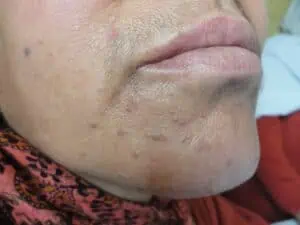
Medically reviewed by Julie Forero, DO
Could you have warts and not even know it? You might if they’re flat warts, known medically as verruca plana. These warts are flatter, smoother and smaller than their uglier, bulbous cousins. If you’ve noticed small, slightly raised growths on your face, hands or other body parts and dismissed them as age spots or stubborn acne, the real culprit may be flat warts.
Flat warts aren’t harmful or painful, but you may want to get rid of them for aesthetic reasons. If you suspect you have flat warts on your face, hands, legs or elsewhere, read on to learn why they develop, how to tell them apart from other common skin conditions and options for flat wart treatment.
What do flat warts look like?
Flat warts are small—usually 1-5 millimeters wide. They are slightly raised and tend to be round or oval. They’re often the same color as your skin, though they may be pink or yellow brown.
Flat warts commonly appear on the face, legs and back of the hands. Even though they’re small, they tend to show up in clusters of 20 to 100, so they can be hard to miss.
What causes flat warts?
Like all warts, flat warts are caused by human papillomavirus (HPV), a common and contagious virus. They can be caused by one of four strains—different from the strain that causes flat genital warts.
You can contract the strains of HPV that cause flat warts through cuts or breaks in the skin, especially nicks from shaving. That may explain why flat warts are common in young people who are just learning to shave, and why women tend to see flat warts on their legs while men get flat warts on their face, including the beard area.
Other risk factors for flat warts include:
- Close contact with someone who has HPV
- Touching something handled by a person with HPV
- Poor hygiene
- Having a weakened immune system
Other skin conditions that look similar to flat warts
It’s easy to confuse flat warts with other skin conditions. Brown flat warts, for example, can sometimes resemble age spots or small moles, while pink ones could look like acne. Flat warts can also be mistaken for skin tags, milia and seborrheic keratoses.
Flat wart vs. skin tag
Some skin tags are connected to the skin by a stalk, but others are fixed on the skin and can look like flat warts when they’re small. Location is one way to help distinguish the two: Skin tags usually appear on areas where the skin folds, such as the eyelids, underarms and beneath the breasts.
Milia vs. flat warts
Small bumps on your face? They could be small cysts called milia. Flat warts and milia share several traits—they’re both small, can be yellowish and appear in clusters. But flat warts have a flat top, whereas milia are firm, domed-shaped bumps. Flat warts can occur on the face, hands or legs, but milia occur mainly on the face. And while milia can be yellowish, they are often pearl-colored.
Flat wart vs. seborrheic keratoses
Like flat warts, benign skin growths called seborrheic keratoses are round or oval and at least slightly raised. But they’re typically rough, with a lumpy surface. They may look scaly, waxy and “pasted on.” They can be light tan, brown or black.
Flat wart treatment
Flat warts usually go away on their own, but it can take months or years. If you don’t want to wait, you can try to treat them at home with an over-the-counter wart remover that contains salicylic acid. (Ignore any wart home remedies you see online—some could burn and even scar your skin.) If you don’t see results, visit your dermatologist.
The usual wart treatments, such as freezing them with cryosurgery or burning them with an electric needle and then scraping them off, typically aren’t ideal for treating multiple flat warts. Chemical peels are often a better bet. Your dermatologist may prescribe prescription-strength salicylic acid, glycolic acid, tretinoin or some combination of these topicals for you to apply to the flat warts at home every day.
Laser treatment is another option, as is photodynamic therapy. In photodynamic therapy, the doctor applies a topical medicine that damages the DNA of fast-growing cells and activates the medicine with light, usually from a laser.
Is there any way to prevent flat warts?
Protecting your skin from HPV viruses involves the same strategies as protecting it from other microbes.
- Keep your skin clean and dry.
- Avoid skin-to-skin contact with anyone who has flat warts.
- Don’t share personal items such as towels or clothing with anyone who has flat warts.
- Wear flip-flops at the pool and in locker rooms and public showers.
- Don’t bite or chew your fingernails or cuticles.
- Clean cuts and scratches with soap and water.
Written by Jessica Brown, a health and science writer/editor based in Nanuet, New York. She has written for Prevention magazine, jnj.com, BCRF.org, and many other outlets.

